Nursing Ethics: An Analysis of Informed Consent Dilemma in Australia
VerifiedAdded on 2022/09/13
|6
|1571
|10
Essay
AI Summary
This essay presents a case study of a nursing ethics dilemma concerning informed consent within an Australian healthcare setting. The scenario involves an Aboriginal patient with anemia who initially refused a blood transfusion due to cultural beliefs. Despite the patient's refusal, doctors proceeded with the transfusion, leading to an ethical conflict for the nurse. The essay explores the clash between patient autonomy, the doctor's perception of medical necessity, and the nurse's ethical obligations as guided by the Australian Nurses' Code of Ethics. It examines the legal implications of informed consent, considering the patient's capacity and rationality, and the potential influence of cultural beliefs. The analysis highlights the challenges nurses face in balancing patient rights with the perceived best interests of the patient, particularly when dealing with potentially irrational decisions. The essay emphasizes the importance of clear communication, cultural sensitivity, and the nurse's role in safeguarding patient dignity. It also examines the impact of such ethical dilemmas on the nursing profession and the need for nurses to balance universal human rights with the rationality of medical treatments.
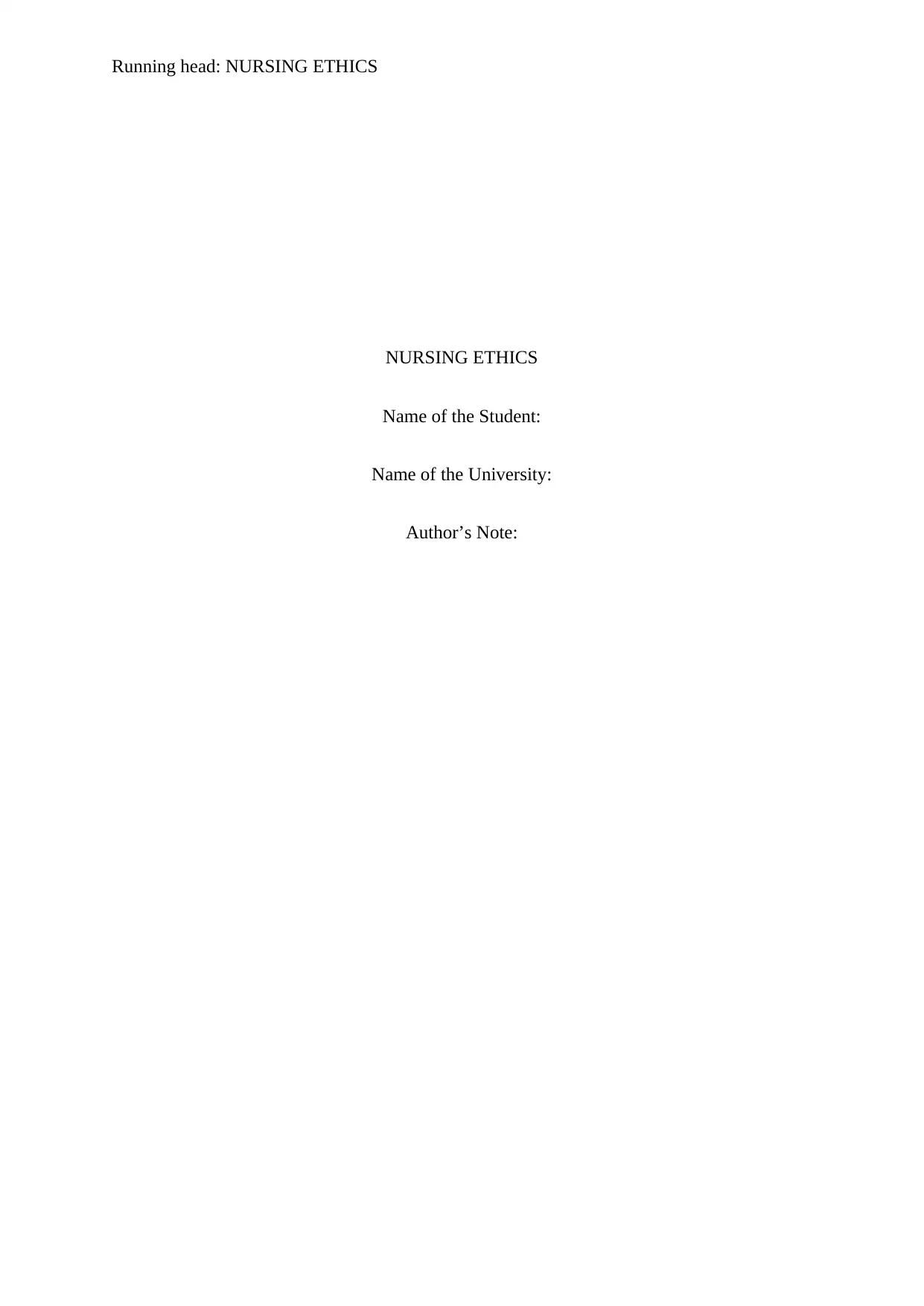
Running head: NURSING ETHICS
NURSING ETHICS
Name of the Student:
Name of the University:
Author’s Note:
NURSING ETHICS
Name of the Student:
Name of the University:
Author’s Note:
Paraphrase This Document
Need a fresh take? Get an instant paraphrase of this document with our AI Paraphraser
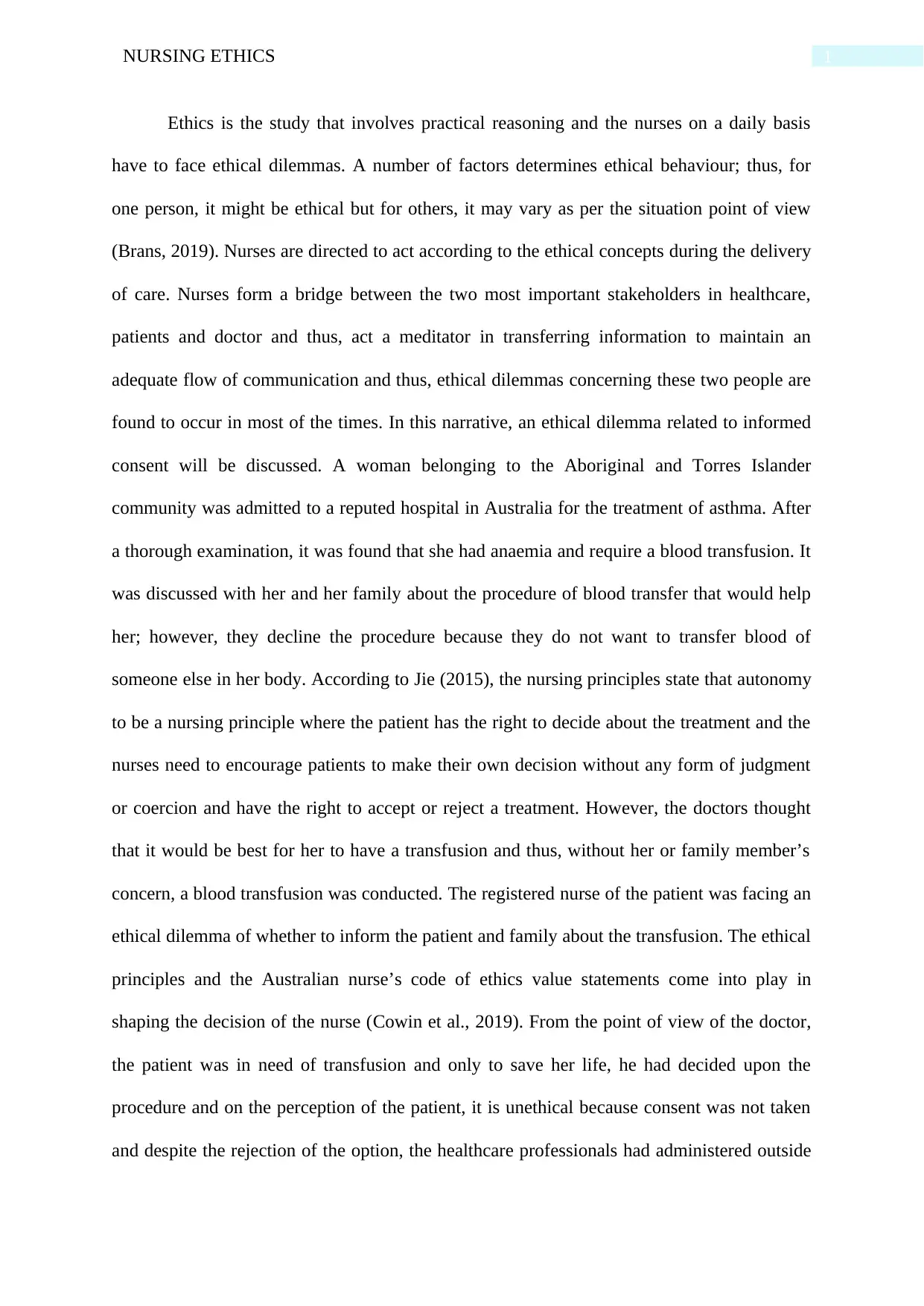
1NURSING ETHICS
Ethics is the study that involves practical reasoning and the nurses on a daily basis
have to face ethical dilemmas. A number of factors determines ethical behaviour; thus, for
one person, it might be ethical but for others, it may vary as per the situation point of view
(Brans, 2019). Nurses are directed to act according to the ethical concepts during the delivery
of care. Nurses form a bridge between the two most important stakeholders in healthcare,
patients and doctor and thus, act a meditator in transferring information to maintain an
adequate flow of communication and thus, ethical dilemmas concerning these two people are
found to occur in most of the times. In this narrative, an ethical dilemma related to informed
consent will be discussed. A woman belonging to the Aboriginal and Torres Islander
community was admitted to a reputed hospital in Australia for the treatment of asthma. After
a thorough examination, it was found that she had anaemia and require a blood transfusion. It
was discussed with her and her family about the procedure of blood transfer that would help
her; however, they decline the procedure because they do not want to transfer blood of
someone else in her body. According to Jie (2015), the nursing principles state that autonomy
to be a nursing principle where the patient has the right to decide about the treatment and the
nurses need to encourage patients to make their own decision without any form of judgment
or coercion and have the right to accept or reject a treatment. However, the doctors thought
that it would be best for her to have a transfusion and thus, without her or family member’s
concern, a blood transfusion was conducted. The registered nurse of the patient was facing an
ethical dilemma of whether to inform the patient and family about the transfusion. The ethical
principles and the Australian nurse’s code of ethics value statements come into play in
shaping the decision of the nurse (Cowin et al., 2019). From the point of view of the doctor,
the patient was in need of transfusion and only to save her life, he had decided upon the
procedure and on the perception of the patient, it is unethical because consent was not taken
and despite the rejection of the option, the healthcare professionals had administered outside
Ethics is the study that involves practical reasoning and the nurses on a daily basis
have to face ethical dilemmas. A number of factors determines ethical behaviour; thus, for
one person, it might be ethical but for others, it may vary as per the situation point of view
(Brans, 2019). Nurses are directed to act according to the ethical concepts during the delivery
of care. Nurses form a bridge between the two most important stakeholders in healthcare,
patients and doctor and thus, act a meditator in transferring information to maintain an
adequate flow of communication and thus, ethical dilemmas concerning these two people are
found to occur in most of the times. In this narrative, an ethical dilemma related to informed
consent will be discussed. A woman belonging to the Aboriginal and Torres Islander
community was admitted to a reputed hospital in Australia for the treatment of asthma. After
a thorough examination, it was found that she had anaemia and require a blood transfusion. It
was discussed with her and her family about the procedure of blood transfer that would help
her; however, they decline the procedure because they do not want to transfer blood of
someone else in her body. According to Jie (2015), the nursing principles state that autonomy
to be a nursing principle where the patient has the right to decide about the treatment and the
nurses need to encourage patients to make their own decision without any form of judgment
or coercion and have the right to accept or reject a treatment. However, the doctors thought
that it would be best for her to have a transfusion and thus, without her or family member’s
concern, a blood transfusion was conducted. The registered nurse of the patient was facing an
ethical dilemma of whether to inform the patient and family about the transfusion. The ethical
principles and the Australian nurse’s code of ethics value statements come into play in
shaping the decision of the nurse (Cowin et al., 2019). From the point of view of the doctor,
the patient was in need of transfusion and only to save her life, he had decided upon the
procedure and on the perception of the patient, it is unethical because consent was not taken
and despite the rejection of the option, the healthcare professionals had administered outside
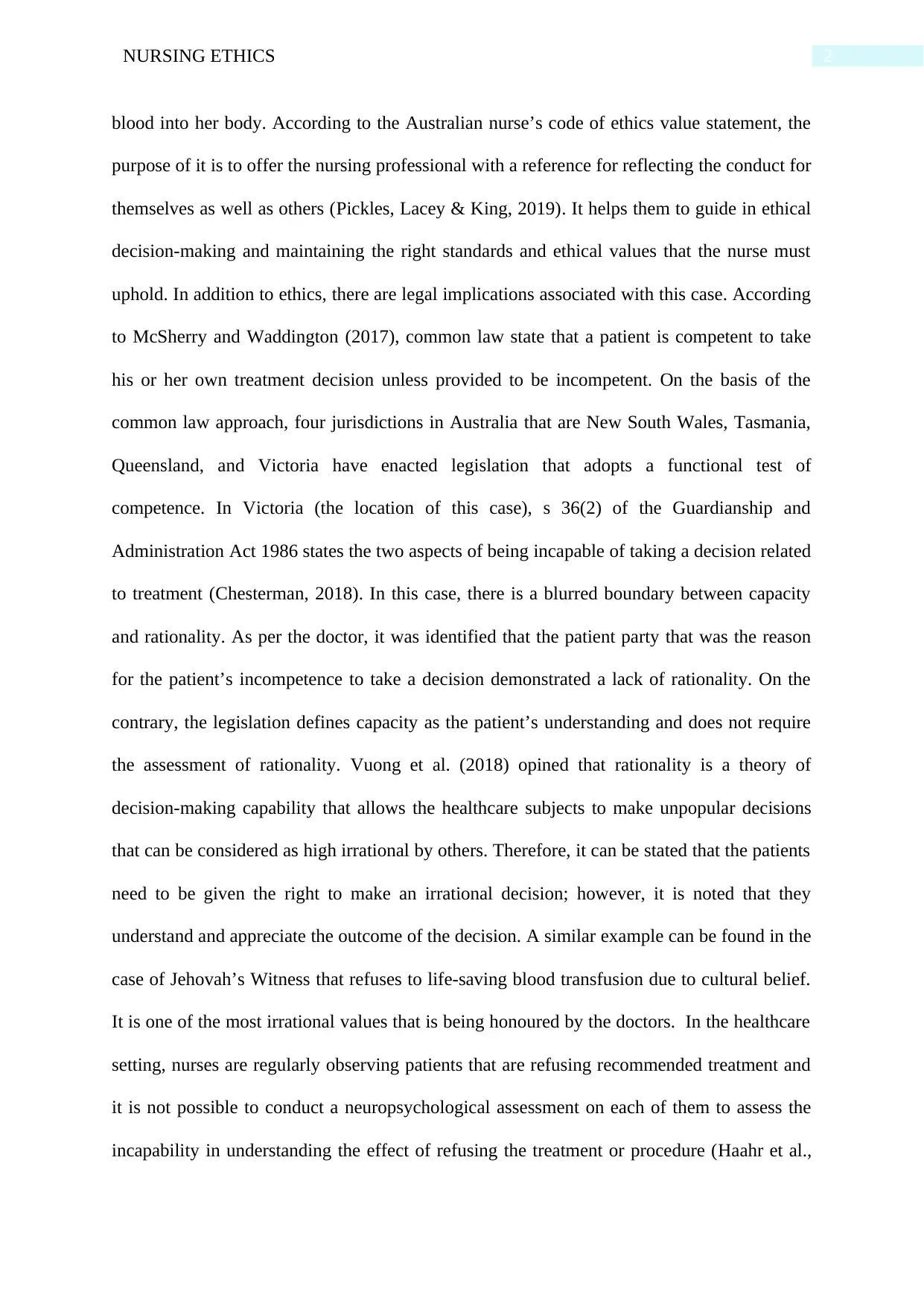
2NURSING ETHICS
blood into her body. According to the Australian nurse’s code of ethics value statement, the
purpose of it is to offer the nursing professional with a reference for reflecting the conduct for
themselves as well as others (Pickles, Lacey & King, 2019). It helps them to guide in ethical
decision-making and maintaining the right standards and ethical values that the nurse must
uphold. In addition to ethics, there are legal implications associated with this case. According
to McSherry and Waddington (2017), common law state that a patient is competent to take
his or her own treatment decision unless provided to be incompetent. On the basis of the
common law approach, four jurisdictions in Australia that are New South Wales, Tasmania,
Queensland, and Victoria have enacted legislation that adopts a functional test of
competence. In Victoria (the location of this case), s 36(2) of the Guardianship and
Administration Act 1986 states the two aspects of being incapable of taking a decision related
to treatment (Chesterman, 2018). In this case, there is a blurred boundary between capacity
and rationality. As per the doctor, it was identified that the patient party that was the reason
for the patient’s incompetence to take a decision demonstrated a lack of rationality. On the
contrary, the legislation defines capacity as the patient’s understanding and does not require
the assessment of rationality. Vuong et al. (2018) opined that rationality is a theory of
decision-making capability that allows the healthcare subjects to make unpopular decisions
that can be considered as high irrational by others. Therefore, it can be stated that the patients
need to be given the right to make an irrational decision; however, it is noted that they
understand and appreciate the outcome of the decision. A similar example can be found in the
case of Jehovah’s Witness that refuses to life-saving blood transfusion due to cultural belief.
It is one of the most irrational values that is being honoured by the doctors. In the healthcare
setting, nurses are regularly observing patients that are refusing recommended treatment and
it is not possible to conduct a neuropsychological assessment on each of them to assess the
incapability in understanding the effect of refusing the treatment or procedure (Haahr et al.,
blood into her body. According to the Australian nurse’s code of ethics value statement, the
purpose of it is to offer the nursing professional with a reference for reflecting the conduct for
themselves as well as others (Pickles, Lacey & King, 2019). It helps them to guide in ethical
decision-making and maintaining the right standards and ethical values that the nurse must
uphold. In addition to ethics, there are legal implications associated with this case. According
to McSherry and Waddington (2017), common law state that a patient is competent to take
his or her own treatment decision unless provided to be incompetent. On the basis of the
common law approach, four jurisdictions in Australia that are New South Wales, Tasmania,
Queensland, and Victoria have enacted legislation that adopts a functional test of
competence. In Victoria (the location of this case), s 36(2) of the Guardianship and
Administration Act 1986 states the two aspects of being incapable of taking a decision related
to treatment (Chesterman, 2018). In this case, there is a blurred boundary between capacity
and rationality. As per the doctor, it was identified that the patient party that was the reason
for the patient’s incompetence to take a decision demonstrated a lack of rationality. On the
contrary, the legislation defines capacity as the patient’s understanding and does not require
the assessment of rationality. Vuong et al. (2018) opined that rationality is a theory of
decision-making capability that allows the healthcare subjects to make unpopular decisions
that can be considered as high irrational by others. Therefore, it can be stated that the patients
need to be given the right to make an irrational decision; however, it is noted that they
understand and appreciate the outcome of the decision. A similar example can be found in the
case of Jehovah’s Witness that refuses to life-saving blood transfusion due to cultural belief.
It is one of the most irrational values that is being honoured by the doctors. In the healthcare
setting, nurses are regularly observing patients that are refusing recommended treatment and
it is not possible to conduct a neuropsychological assessment on each of them to assess the
incapability in understanding the effect of refusing the treatment or procedure (Haahr et al.,
⊘ This is a preview!⊘
Do you want full access?
Subscribe today to unlock all pages.

Trusted by 1+ million students worldwide
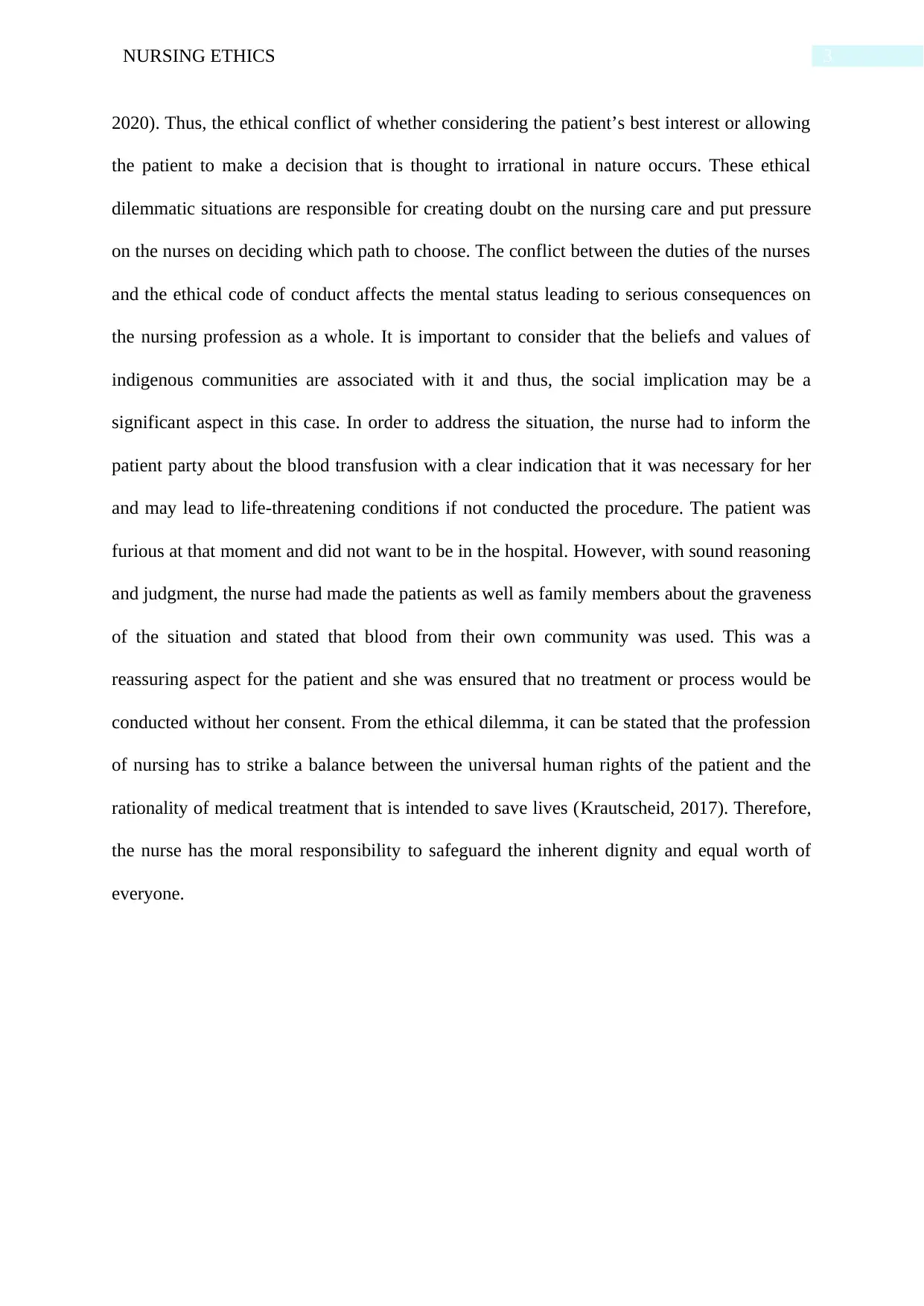
3NURSING ETHICS
2020). Thus, the ethical conflict of whether considering the patient’s best interest or allowing
the patient to make a decision that is thought to irrational in nature occurs. These ethical
dilemmatic situations are responsible for creating doubt on the nursing care and put pressure
on the nurses on deciding which path to choose. The conflict between the duties of the nurses
and the ethical code of conduct affects the mental status leading to serious consequences on
the nursing profession as a whole. It is important to consider that the beliefs and values of
indigenous communities are associated with it and thus, the social implication may be a
significant aspect in this case. In order to address the situation, the nurse had to inform the
patient party about the blood transfusion with a clear indication that it was necessary for her
and may lead to life-threatening conditions if not conducted the procedure. The patient was
furious at that moment and did not want to be in the hospital. However, with sound reasoning
and judgment, the nurse had made the patients as well as family members about the graveness
of the situation and stated that blood from their own community was used. This was a
reassuring aspect for the patient and she was ensured that no treatment or process would be
conducted without her consent. From the ethical dilemma, it can be stated that the profession
of nursing has to strike a balance between the universal human rights of the patient and the
rationality of medical treatment that is intended to save lives (Krautscheid, 2017). Therefore,
the nurse has the moral responsibility to safeguard the inherent dignity and equal worth of
everyone.
2020). Thus, the ethical conflict of whether considering the patient’s best interest or allowing
the patient to make a decision that is thought to irrational in nature occurs. These ethical
dilemmatic situations are responsible for creating doubt on the nursing care and put pressure
on the nurses on deciding which path to choose. The conflict between the duties of the nurses
and the ethical code of conduct affects the mental status leading to serious consequences on
the nursing profession as a whole. It is important to consider that the beliefs and values of
indigenous communities are associated with it and thus, the social implication may be a
significant aspect in this case. In order to address the situation, the nurse had to inform the
patient party about the blood transfusion with a clear indication that it was necessary for her
and may lead to life-threatening conditions if not conducted the procedure. The patient was
furious at that moment and did not want to be in the hospital. However, with sound reasoning
and judgment, the nurse had made the patients as well as family members about the graveness
of the situation and stated that blood from their own community was used. This was a
reassuring aspect for the patient and she was ensured that no treatment or process would be
conducted without her consent. From the ethical dilemma, it can be stated that the profession
of nursing has to strike a balance between the universal human rights of the patient and the
rationality of medical treatment that is intended to save lives (Krautscheid, 2017). Therefore,
the nurse has the moral responsibility to safeguard the inherent dignity and equal worth of
everyone.
Paraphrase This Document
Need a fresh take? Get an instant paraphrase of this document with our AI Paraphraser
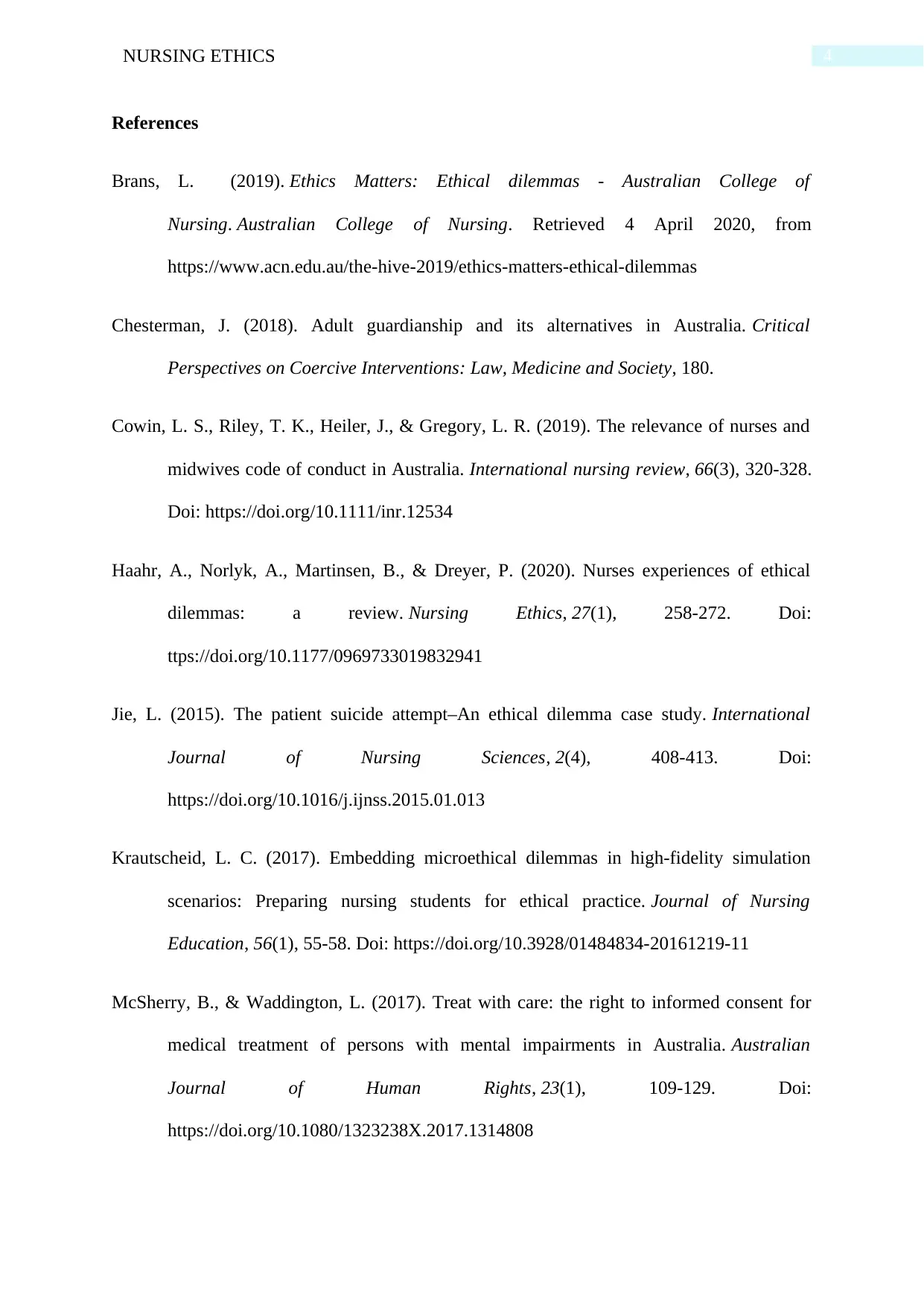
4NURSING ETHICS
References
Brans, L. (2019). Ethics Matters: Ethical dilemmas - Australian College of
Nursing. Australian College of Nursing. Retrieved 4 April 2020, from
https://www.acn.edu.au/the-hive-2019/ethics-matters-ethical-dilemmas
Chesterman, J. (2018). Adult guardianship and its alternatives in Australia. Critical
Perspectives on Coercive Interventions: Law, Medicine and Society, 180.
Cowin, L. S., Riley, T. K., Heiler, J., & Gregory, L. R. (2019). The relevance of nurses and
midwives code of conduct in Australia. International nursing review, 66(3), 320-328.
Doi: https://doi.org/10.1111/inr.12534
Haahr, A., Norlyk, A., Martinsen, B., & Dreyer, P. (2020). Nurses experiences of ethical
dilemmas: a review. Nursing Ethics, 27(1), 258-272. Doi:
ttps://doi.org/10.1177/0969733019832941
Jie, L. (2015). The patient suicide attempt–An ethical dilemma case study. International
Journal of Nursing Sciences, 2(4), 408-413. Doi:
https://doi.org/10.1016/j.ijnss.2015.01.013
Krautscheid, L. C. (2017). Embedding microethical dilemmas in high-fidelity simulation
scenarios: Preparing nursing students for ethical practice. Journal of Nursing
Education, 56(1), 55-58. Doi: https://doi.org/10.3928/01484834-20161219-11
McSherry, B., & Waddington, L. (2017). Treat with care: the right to informed consent for
medical treatment of persons with mental impairments in Australia. Australian
Journal of Human Rights, 23(1), 109-129. Doi:
https://doi.org/10.1080/1323238X.2017.1314808
References
Brans, L. (2019). Ethics Matters: Ethical dilemmas - Australian College of
Nursing. Australian College of Nursing. Retrieved 4 April 2020, from
https://www.acn.edu.au/the-hive-2019/ethics-matters-ethical-dilemmas
Chesterman, J. (2018). Adult guardianship and its alternatives in Australia. Critical
Perspectives on Coercive Interventions: Law, Medicine and Society, 180.
Cowin, L. S., Riley, T. K., Heiler, J., & Gregory, L. R. (2019). The relevance of nurses and
midwives code of conduct in Australia. International nursing review, 66(3), 320-328.
Doi: https://doi.org/10.1111/inr.12534
Haahr, A., Norlyk, A., Martinsen, B., & Dreyer, P. (2020). Nurses experiences of ethical
dilemmas: a review. Nursing Ethics, 27(1), 258-272. Doi:
ttps://doi.org/10.1177/0969733019832941
Jie, L. (2015). The patient suicide attempt–An ethical dilemma case study. International
Journal of Nursing Sciences, 2(4), 408-413. Doi:
https://doi.org/10.1016/j.ijnss.2015.01.013
Krautscheid, L. C. (2017). Embedding microethical dilemmas in high-fidelity simulation
scenarios: Preparing nursing students for ethical practice. Journal of Nursing
Education, 56(1), 55-58. Doi: https://doi.org/10.3928/01484834-20161219-11
McSherry, B., & Waddington, L. (2017). Treat with care: the right to informed consent for
medical treatment of persons with mental impairments in Australia. Australian
Journal of Human Rights, 23(1), 109-129. Doi:
https://doi.org/10.1080/1323238X.2017.1314808
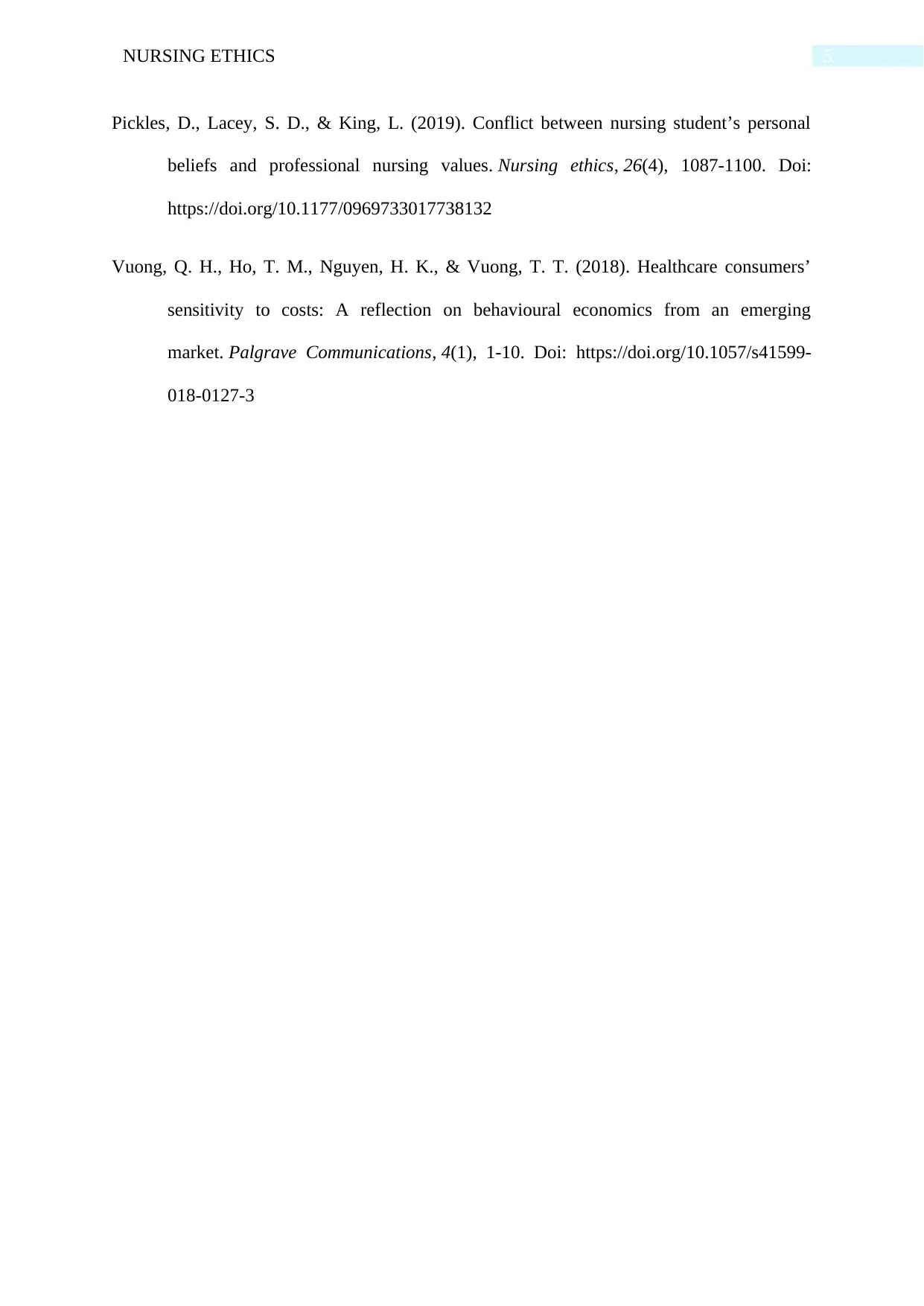
5NURSING ETHICS
Pickles, D., Lacey, S. D., & King, L. (2019). Conflict between nursing student’s personal
beliefs and professional nursing values. Nursing ethics, 26(4), 1087-1100. Doi:
https://doi.org/10.1177/0969733017738132
Vuong, Q. H., Ho, T. M., Nguyen, H. K., & Vuong, T. T. (2018). Healthcare consumers’
sensitivity to costs: A reflection on behavioural economics from an emerging
market. Palgrave Communications, 4(1), 1-10. Doi: https://doi.org/10.1057/s41599-
018-0127-3
Pickles, D., Lacey, S. D., & King, L. (2019). Conflict between nursing student’s personal
beliefs and professional nursing values. Nursing ethics, 26(4), 1087-1100. Doi:
https://doi.org/10.1177/0969733017738132
Vuong, Q. H., Ho, T. M., Nguyen, H. K., & Vuong, T. T. (2018). Healthcare consumers’
sensitivity to costs: A reflection on behavioural economics from an emerging
market. Palgrave Communications, 4(1), 1-10. Doi: https://doi.org/10.1057/s41599-
018-0127-3
⊘ This is a preview!⊘
Do you want full access?
Subscribe today to unlock all pages.

Trusted by 1+ million students worldwide
1 out of 6
Related Documents
Your All-in-One AI-Powered Toolkit for Academic Success.
+13062052269
info@desklib.com
Available 24*7 on WhatsApp / Email
![[object Object]](/_next/static/media/star-bottom.7253800d.svg)
Unlock your academic potential
Copyright © 2020–2025 A2Z Services. All Rights Reserved. Developed and managed by ZUCOL.





